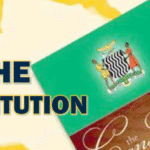Abstract
THIS paper is purely meant as a contribution to financial literacy in Zambia and in no way undermines government’s efforts towards economic development.
Since taking office in August 2021, President Hakainde Hichilema has embarked on a bold economic reform agenda aimed at restoring fiscal stability, promoting inclusive growth, and modernising Zambia’s infrastructure.
This paper highlights key economic achievements under his administration – particularly in debt management, investment mobilisation, infrastructure, agriculture, and decentralisation – while also acknowledging persistent structural challenges. It concludes with a forward-looking analysis of Zambia’s development trajectory.
- Introduction
President Hichilema inherited a deeply strained economy marked by high inflation, unsustainable debt, low investor confidence and high youth unemployment. Guided by principles of fiscal prudence, public-private collaboration and grassroots empowerment, the UPND administration launched reforms targeting key economic sectors.
This appraisal explores the administration’s performance, with an emphasis on positive strides, while critically assessing the underlying challenges that may affect the pace and depth of transformation.
- Fiscal discipline and debt restructuring
Achievements:
* Successfully restructured $13.4 billion of external debt under the G20 Common Framework, easing debt service pressures and restoring fiscal space.
* Fiscal deficit reduced from over nine percent of GDP in 2020 to under six percent by 2024.
* Inflation fell from 24.4 percent in August 2021 to 8.9 percent by end of 2023.
* Deployment of electronic Government Procurement (e-GP) improved transparency and efficiency.
Challenges:
* Public debt remains high at over 80 percent of GDP despite restructuring, limiting spending flexibility.
* Dependence on external financing and IMF programmes requires difficult fiscal adjustments, including subsidy rationalisation and public wage containment.
- Economic growth and investment mobilisation
Achievements:
* Real GDP growth reached 8.6 percent in Q4 2024, far surpassing the IMF projection of 1.2 percent.
* Over $8.3 billion in foreign direct investment (FDI) pledges were secured between 2021 and 2024.
* Exchange rate stabilisation helped attract portfolio and equity investments.
Challenges:
* Growth remains heavily dependent on copper exports, leaving the economy vulnerable to global commodity price fluctuations.
* Private sector credit growth is still constrained by high interest rates and limited financial access for SMEs.
- Infrastructure and Public-Private Partnerships (PPPs)
Achievements:
* Major projects under PPPs include:
o Lusaka–Ndola dual carriageway ($577 million)
o Chingola–Kasumbalesa Road
o Itimpi Solar Project (60 MW) – contributing to renewable energy expansion
* Significant investment in rural electrification, feeder roads, and trade logistics infrastructure
Challenges:
* Delays in PPP project execution due to bureaucratic and legal bottlenecks
* Maintenance gaps in rural infrastructure and limited local contractor capacity
- Job creation and human capital development
Achievements:
* Recruited over 30, 000 teachers and 11, 000 health workers (2022–2024)
* Introduced free education policy, increasing school enrollment
* Expanded technical and vocational education training programmes across provinces
Challenges:
* Youth unemployment remains above 20 percent, especially in urban areas.
* The formal private sector is not yet generating enough jobs to match population growth.
* Many young people remain underemployed or engaged in low-productivity informal work.
- Agricultural sector transformation
Achievements:
* Launched Comprehensive Agriculture Transformation Support Programme (CATSP)
* Over 800 cooperatives empowered through CDF funding and input support
* Irrigation, mechanisation, and agro-processing prioritised to boost productivity
* Signed a $500 million compact with the Millennium Challenge Corporation (MCC) to modernise land and agricultural systems
Challenges:
* Recurring droughts and climate shocks threaten food security and income for farmers.
* Market access and input supply chains remain underdeveloped in remote areas.
* Farmer input distribution delays persist in parts of the country.
- Decentralisation and the Constituency Development Fund (CDF)
Achievements:
* CDF increased from K1.6 million to K25.7 million per constituency
* Local governments empowered to implement community infrastructure, youth grants, and skill development initiatives
* Improved community participation in development planning and implementation
Challenges:
* Slow fund disbursements and low implementation capacity at local level
* Risk of mismanagement or politicisation of funds
* Monitoring and evaluation frameworks still evolving
- Prospects and strategic outlook
Zambia’s medium-term prospects remain strong if reforms continue:
* Energy diversification and regional electricity trade will enhance industrial productivity.
* Agricultural commercialisation and agro-value chains offer pathways for rural employment.
* Digital economy development and fintech innovation are promising emerging sectors.
* Continued anti-corruption reforms and institutional strengthening will be vital to sustaining growth.
- Conclusion
President Hichilema’s administration has made exceptional progress in stabilizing Zambia’s economy, strengthening governance, and promoting investment-led growth.
The expansion of public-private partnerships, the empowerment of local communities through CDF, and focused investments in education and agriculture are laying the groundwork for long-term prosperity.
Nonetheless, structural challenges – such as unemployment, climate vulnerability, and fiscal dependence – persist.
The path ahead will require policy consistency, inclusive execution, and strengthened institutional capacity to ensure that the economic gains are widely felt by ordinary citizens.










